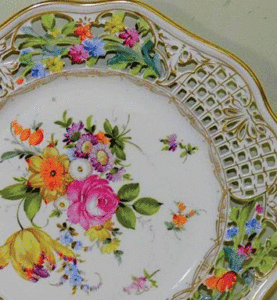
In the early 1700s, the Dresden factory made dinnerware, figures and more, and the demand and flow of business began to pick up.
Dresden porcelain is recognized in the antiques industry as the hallmark of good taste and fine German porcelain manufacturing.
German hard-paste porcelain was produced in the Meissen factory, so Dresden is also known as Meissen, and it began very early, in 1710 in Dresden/Saxony, present day Germany. The Chinese developed a product called porcelain that the Europeans desperately wanted to copy.
Known for the hardness of a rock and the beauty of a shell, manufacturers could not figure out how, indeed, it was made.
The secret of porcelain, the ultimate ingredient being kaolin, was discovered and copied by alchemists and physicists in 1707, opening up the market for Germans to produce a hard-paste porcelain, ripe for the hungry European markets
In the early 1700s, the Dresden factory made dinnerware, figures and more, and the demand and flow of business began to pick up.
Dresden-decorated porcelain was popular, and in 1731, a sculptor named Johann Joachim Kandler developed a decoration called onion pattern, which was widely copied and admired.
The porcelain has a mark of crossed blue swords for antique identification purposes.
We take porcelain and the secret that it holds for granted in modern times, but in the early 1700s, Dresden dominated European porcelain manufacturing until about 1756, when it was surpassed by the famous Sevres French porcelain, known for very high standards of excellence in production and quality.
During the early 1880s, the use of the Crown Dresden stamp was used by decorator Helena Wolfsoh, and the crown stamp was registered as the official mark for all Dresden wares, no matter the content.
It is very important to find marks on antiques, usually on the bottom, that identify glazer signatures, dates, symbols and more information that allows a current market to indentify and price an object.
Dresden eventually would go on to support decorating shops throughout World War II, when the entire operation was bombed due to Allied engagement in German territories. In 1945 a devastating bombing campaign killed many people, destroyed Dresden, and brought it to ruins, destroying much of the product, including the factory and operations in that region of Germany.
Eventually, the factory and operations were rebuilt, but it would take a long time, as Europe recovered from the terrible theatre of war.
Many people know Dresden for a famous technique that the company developed, called Dresden lace.
It is very hard to find a piece that is not damaged, but the process involves creating the illusion of real fabric on the figures that Dresden became famous for in production.
Actual lace would be delicately dipped into porcelain slip, fired to hard, leaving a burned off lace, porcelain shell, frozen in time as an exact replica of the original.
Dresden porcelain is known for superb craftsmanship, beautiful, detailed patterns, and excellence around the world.
The company has gone through many changes that have challenged it, from the copying of a porcelain formula secret, a complete bombing of the city in which it was manufactured, and the modern attempts at relevance in the porcelain market.
(Editor’s note: DeeDee Wood is the store manager at Tharpe Antiques, in Easton, part of the Talbot Historical Society.)



